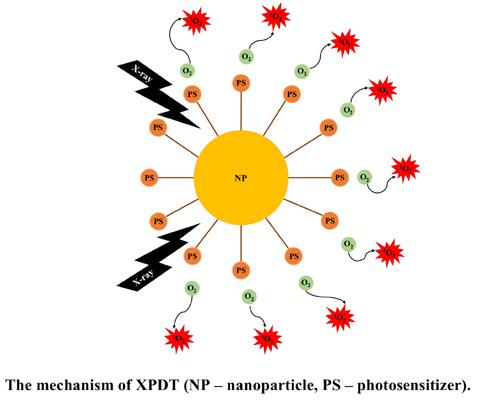Mini-Reviews in Medicinal Chemistry ( IF 3.3 ) Pub Date : 2021-03-31 , DOI: 10.2174/1389557520666201111161705 Daria Yu Kirsanova 1 , Zaira M Gadzhimagomedova 1 , Aleksey Yu Maksimov 2 , Alexander V Soldatov 1

|
According to statistics, cancer is the second leading cause of death in the world. Thus, it is important to solve this medical and social problem by developing new effective methods for cancer treatment. An alternative to more well-known approaches, such as radiotherapy and chemotherapy, is photodynamic therapy (PDT), which is limited to the shallow tissue penetration (< 1 cm) of visible light. Since the PDT process can be initiated in deep tissues by X-ray irradiation (X-ray induced PDT, or XPDT), it has a great potential to treat tumors in internal organs. The article discusses the principles of therapies. The main focus is on various nanoparticles used with or without photosensitizers, which allow the conversion of X-ray irradiation into UV-visible light. Much attention is given to the synthesis of nanoparticles and analysis of their characteristics, such as size and spectral features. The results of in vitro and in vivo experiments are also discussed.
中文翻译:

用于深部肿瘤治疗的纳米材料
据统计,癌症是世界上第二大死亡原因。因此,重要的是通过开发新的有效的癌症治疗方法来解决这个医学和社会问题。光动力疗法(PDT)是更广为人知的方法(例如放射疗法和化学疗法)的替代方法,其仅限于可见光的浅层组织穿透(<1 cm)。由于PDT过程可以通过X射线照射(X射线诱导的PDT或XPDT)在深部组织中引发,因此它在治疗内部器官肿瘤方面具有巨大潜力。本文讨论了治疗原理。主要关注于使用或不使用光敏剂的各种纳米颗粒,它们可以将X射线辐射转换为UV可见光。人们对纳米颗粒的合成及其特征(例如尺寸和光谱特征)的分析给予了极大的关注。还讨论了体外和体内实验的结果。











































 京公网安备 11010802027423号
京公网安备 11010802027423号